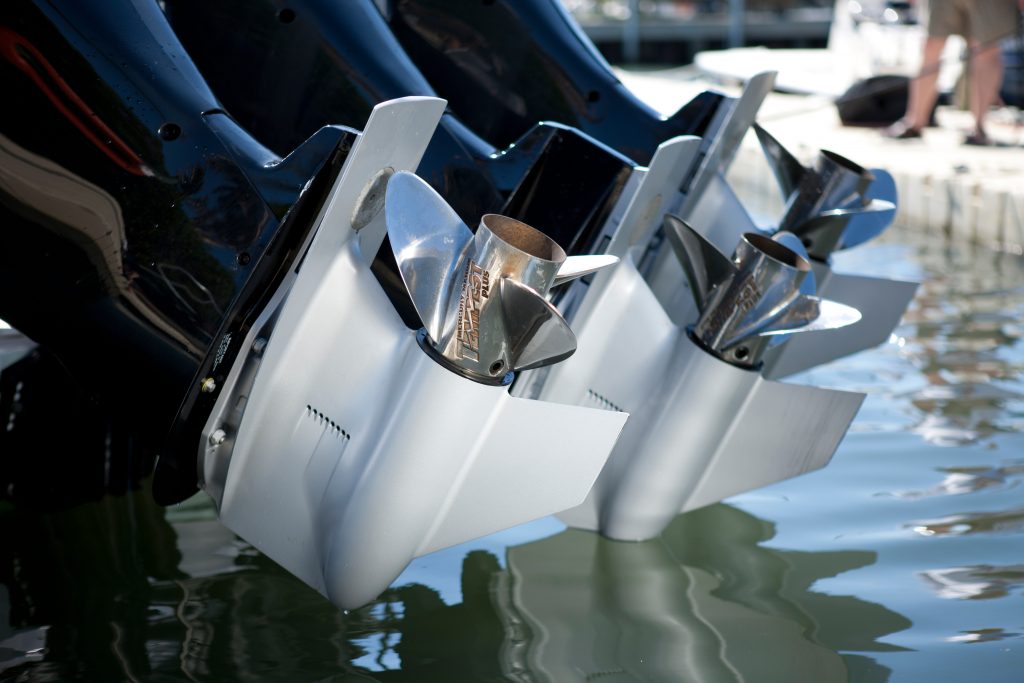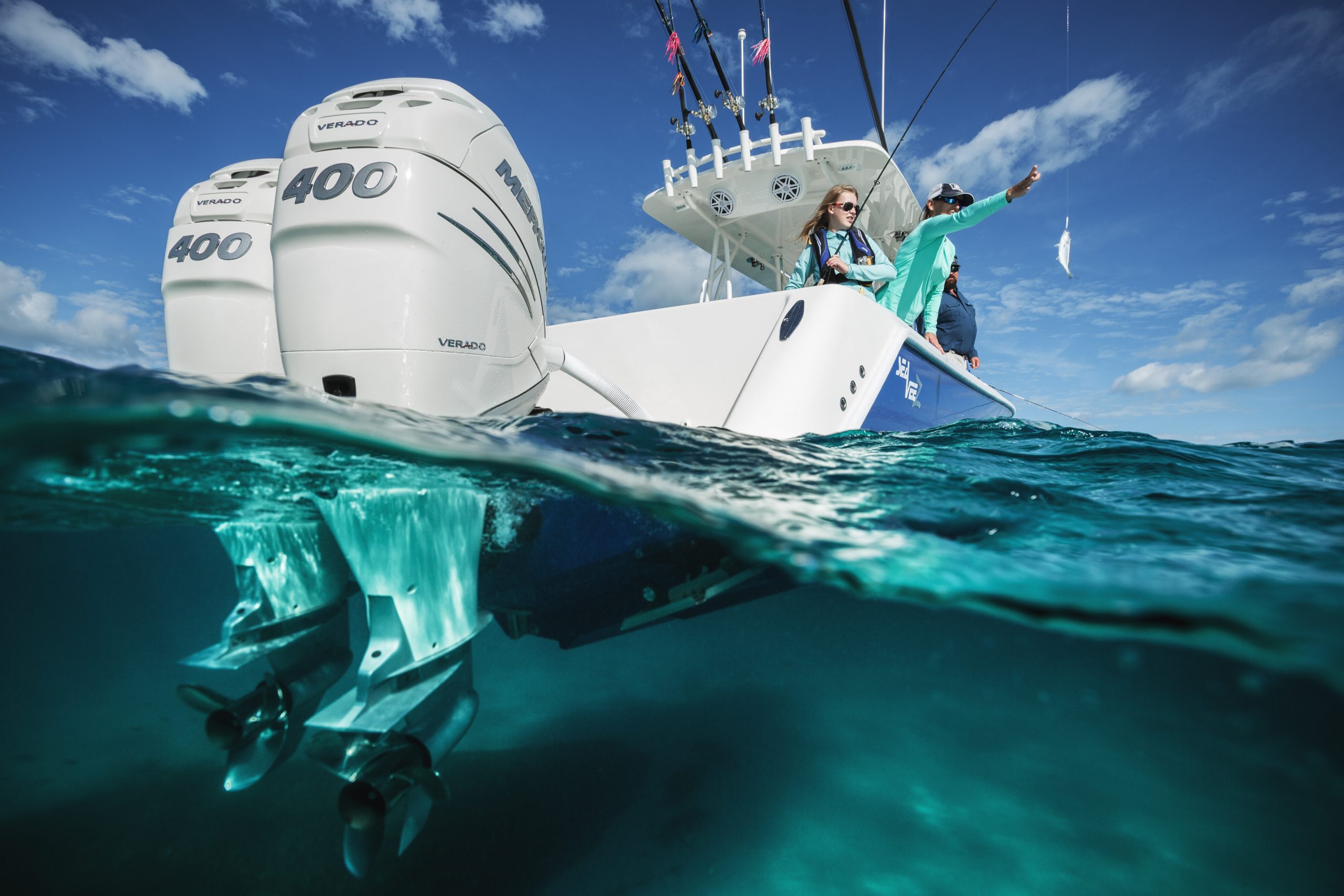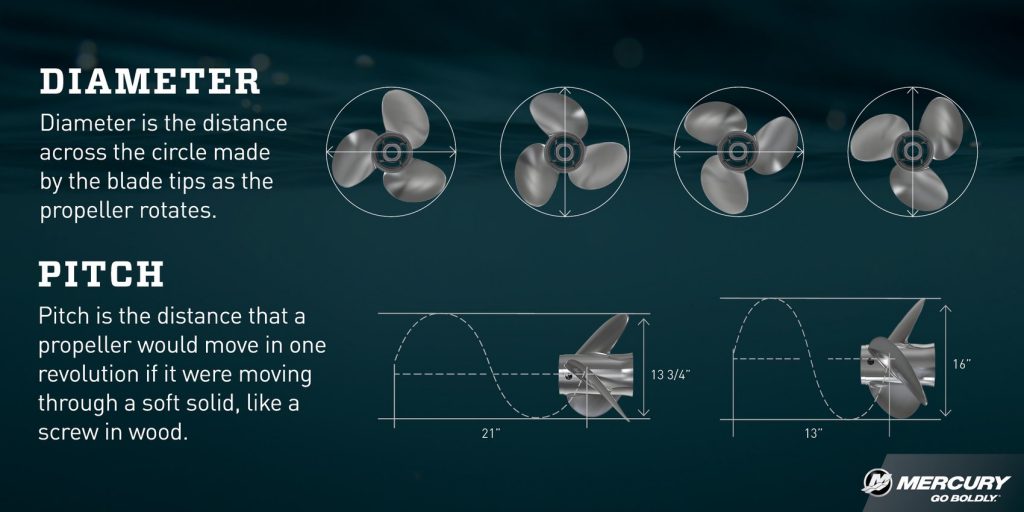By Capt. Bill Jennings
It is easy to forget about Mr. Propeller. All alone and down there in the cold. If you are a boater that takes your propeller for granted, you are not alone. There are so many things going on above the waterline, it’s easy to forget what’s happening below.
I’m sure you realize that without a propeller, your boat won’t go very far. What you may not understand is why the right propeller is critical to performance and what you can do to get the most out of the propeller that you have.
The right propeller
There are some simple things to know about a propeller that will make you more knowledgeable than the average boater. It starts with the two numbers used to identify your prop – – ‘diameter’ and ‘pitch’. Looking at your propeller from the back, ‘diameter’ is the distance in inches- from the center of your prop to the tip of a blade- multiplied by two.
Let’s say the distance on your prop is 15 inches, then the diameter number for your prop is 15. The pitch number is more theoretical. It is the distance in inches that your propeller will move forward, while making one full revolution. This is measured as if the prop was in a solid or in a jello like material and screwing itself forward. If that distance for your prop is 19 inches forward, then you have a 19-inch pitch.
Don’t be confused by a prop that has a third number. That third number could just be indicating the number of blades or blade shape and not related to the first two numbers which are the diameter and pitch. I remember which comes first by remembering that in the alphabet, D for diameter comes before P for pitch.
Knowing this, you might ask: “If I want to go fast, would I not just install a prop with a very high pitch number?” For example, if I went from a 19” pitch to a 28” pitch, I would move forward 28” with every revolution and not just 19” forward, thereby travel a lot faster?
Well, this is true except for one thing. Your prop is performing work, and to produce work, you need horsepower. Your prop will push, (and pull) your boat forward by increasing its revolution, right up to the point where it runs out of available horsepower. When you ask Mr. Propeller to push more water than he has horsepower to accomplish, you do not increase speed.
Also, if you were to change your 19” pitch prop down to a 15” pitch prop, Mr. propeller would have more horsepower than he needs to reach and exceed the maximum rated RPM for your engine – – and you could damage your motor. Every engine comes with a unique manufacturer’s recommended maximum RPM level.
You can now see that the correct propeller is one that can do the work to spin up to the manufacturer’s recommended maximum RPM level, but not go beyond that RPM level when at full throttle. (IE over-rev.)
The easy way to check that you have the right propeller
Knowing the above, you can check your propeller’s efficiency by running your boat on a flat or light chop water surface, up to full throttle and noting your engine RPMs. Your RPM number when ‘flat-out’, should be very close to the maximum recommended for your motor. Changing to a different propeller that achieves this, will give you a performance improvement

Another consideration in choosing a prop
Without getting too confusing, you might also consider the diameter number of your propeller. Diameter relates more to the ‘amount’ of water being pushed as opposed to the ‘speed’ it is being pushed.
If you increase diameter, you will increase your prop’s grip on the water. Compare this to a snow shovel. If you use a large snow shovel, you will push more snow with every lift. This becomes a benefit if you use your boat for tow sports. Of course, if you increase diameter a lot, you start hitting things like the cavitation plate above the prop, so most props give you more push by increasing the area of the blade.
You can also increase blade area by adding another blade. Viewing from the stern, you can picture how adding blade area, or another blade will visually fill in the circle in which the prop turns. Propellers specify this as a “diameter area ratio”, (DAR). Using up the horsepower work available by increasing blade area, (or DAR) for pulling power, you reduce the work available for increasing pitch, for speed.
Prop Materials
If you have read this far, you are probably a serious boater and if you don’t have a stainless prop, you are probably thinking about getting one. Stainless is about seven times stronger than aluminum and the added strength means they do not need to be as thick at the core. Not surprisingly, a thinner prop translates to more speed. The real reason for aluminum or composite props is the low cost. Should you have a prop strike with a stainless prop, damage to shaft or gears is rare, thanks to hub systems that spin when jammed.

Caring for your prop
Everything on a boat seems to require care and props are no exception. Experimenting with props has taught me some noteworthy facts. You can do some strange things to a propeller without seriously affecting performance. This includes drilling small holes in the blade or adding glue pimples.
However, if the leading edge of your prop is even slightly scored or roughened, your boat’s performance will drop significantly. For this reason, you should check your prop periodically for any damage to the leading edge and using a fine file, take off any rough edges, being careful not to take off an amount that changes the blade balance.
Knowing this should make both you and Mr. Propeller much happier.
Keyword : accessories, boat, boat accessories, Boat care, boat gear, Boat Maintenance, Boating, boating life, boating safety, Captain Bill Jennings, diameter, Enertia, maintenance, Max RPM, Mercury, Mercury Marine, Mercury Propeller, mercury spitfire propeller, Pitch, power boat, power boating, Power Boating Canada, powerboating, Prop, Propeller, propeller diameter, Propeller Maintenance, Propeller pitch, safety, spitfire, spitfire propeller, stainless steel accessories, boat, boat accessories, Boat care, boat gear, Boat Maintenance, Boating, boating life, boating safety, Captain Bill Jennings, diameter, Enertia, maintenance, Max RPM, Mercury, Mercury Marine, Mercury Propeller, mercury spitfire propeller, Pitch, power boat, power boating, Power Boating Canada, powerboating, Prop, Propeller, propeller diameter, Propeller Maintenance, Propeller pitch, safety, spitfire, spitfire propeller, stainless steel


